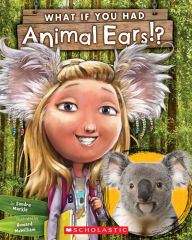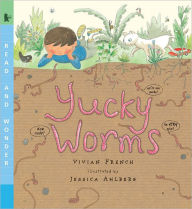Steve Jenkins is a master at delivering science in accessible fun books that kids, teachers, and librarians love. His honors include the Caldecott Honor Award, a NEW YORK TIMES Ten Best Illustrated citation, a BOSTON GLOBE/HORN BOOK Award for Nonfiction, and several ALA Notables.
Bones: Skeletons & How They Work
Hardcover
$19.99
- ISBN-13: 9780545046510
- Publisher: Scholastic, Inc.
- Publication date: 08/01/2010
- Pages: 48
- Sales rank: 151,140
- Product dimensions: 9.20(w) x 11.10(h) x 0.50(d)
- Lexile: AD980L (what's this?)
- Age Range: 7 - 10 Years
Eligible for FREE SHIPPING details
.
19.99
Out Of Stock
Caldecott Honor winner Steve Jenkins presents a fascinating look at the bones of the human body as compared to the bones of animals, and shows them off!
This book is far from skinny -- it's the definitive nonfiction title about human and animal bones, delivered with in-your-face accuracy and intrigue. In this visually driven volume, kids come face-to-face with some head-to-toe boney comparisons, many of them shown at actual size. Here you'll find the differences between a man's hand and that of a spider monkey; the great weight of an elephant's leg, paired with the feather-light femur of a stork; and rib-tickling info about snakes and sloths. How many bones are in the whole human body?
Customers Who Bought This Item Also Bought
-
- Animals by the Numbers: A Book…
- by Steve Jenkins
-
- Eye to Eye : How Animals See…
- by Steve Jenkins
-
- The Beetle Book
- by Steve JenkinsSteve Jenkins
-
- Egg : Nature's Perfect…
- by Robin PageSteve Jenkins
-
- Water Is Water: A Book About…
- by Miranda PaulJason Chin
-
- Giant Squid
- by Candace FlemingEric Rohmann
-
- What If You Had Animal Ears?
- by Sandra Markle
-
- Living Sunlight: How Plants…
- by Molly BangPenny Chisholm
-
- I Fall Down
- by Vicki CobbJulia Gorton
-
- Pink Is For Blobfish:…
- by Jess Keating
-
- Digestive System
- by Christine Taylor-Butler
-
- How to Clean a Hippopotamus: A…
- by Robin PageSteve JenkinsSteve Jenkins
-
- A Drop of Water
- by Walter Wick
-
- Coral Reefs
- by Jason ChinJason Chin
-
- Wild Tracks!: A Guide to…
- by Jim Arnosky
-
- Yucky Worms (Read and Wonder…
- by Vivian FrenchJessica Ahlberg
-
- Pierre the Penguin: A True…
- by Jean MarzolloLaura Regan
Recently Viewed
Children's Literature - Heidi Hauser Green
The inimitable Steve Jenkins has done it again. He has used his immense skill at papercraft to create a book that is at once a fascinating work of art and a highly informative, thought-provoking resource. "Bones," he explains, "are alive. They grow as an animal grows, get stronger when they are strained, and repair themselves if they get broken." Together, bones form skeletons which "come in a wide range of shapes and sizes" according to their particular location and function in a given animal's body. Readers move from hand bones through arm bones to foot bones and leg bones to ribs and vertebrae to neck bones and skulls. They learn about joints, skeletal symmetry, and bones in motion. Human bones of every type are depicted in comparison with bones from creatures throughout the animal kingdom, including box turtle, mole, gray whale, python, giraffe and more—even dinosaurs receive due attention! Three remarkable spreads fold out for maximum effect. The concise text presents an abundance of information humorously; for example, the final page declares "Congratulations! You are the proud owner of a complete human skeleton!" Four more text-heavy pages at the end continue to engage the imagination with trivia, such as that the curved iron beams of the Eiffel Tower were inspired by the internal structure of the human thigh bone, or that human babies are born with 300 bones, which change over time to the 206 of adulthood. Even readers who come to the book having never thought much about their body's support structure will want to know more after spending some time with this book. This book is highly recommended for school, classroom, public, and home libraries. Reviewer: Heidi Hauser GreenSchool Library Journal
Gr 3–6—From the life-sized human skull grinning out from the brick-red cover to a complete skeleton waving goodbye from a gatefold late in the book, bones are given an entertaining and fresh treatment. Beginning with the opening spread of life-sized animal bones, human bones are quantified and qualified. Hands, feet, femurs, ribs, spine, and skull are shown and compared to other species. Symmetry and joints as well as adaptations for survival are introduced. Humor abounds in the illustrations as well as in subheadings such as, "That's a Handful," "Big Foot," and "Head Case." Readers will be lured in by interactive touches like "What bone is this?" and the "Some Assembly Required" spread with all 206 adult human bones unlabeled and grouped by body area. Displayed against a navy-blue background, the spread opens to the burnt sienna gatefold mentioned above. Two additional gatefolds include a small python (200 ribs) and a collection of skulls. Jenkins's characteristic cut-paper collages in mottled creams and grays are perfectly suited to the topic and contrasted against solid jewel-tone, full-bleed backgrounds. The precise and scaled representations (many life size) are clearly labeled. Text, other than an opening page, is limited and supports the highly visual and sophisticated treatment. A "More About Bones" spread completes the book with a hodgepodge of fascinating facts. With applications that range from anatomy to evolution and mathematics, this book will find a place in every collection.—Carol S. Surges, McKinley Elementary School, Wauwatosa, WI


















